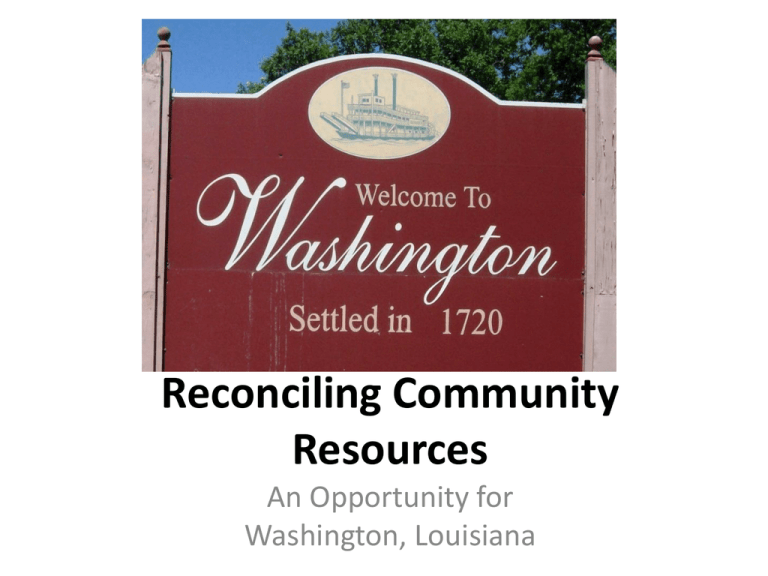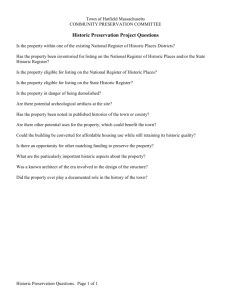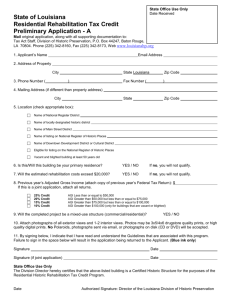Reconciling Community Resources
advertisement

Reconciling Community Resources An Opportunity for Washington, Louisiana MISSION: Our mission is to break the cycle of poverty by providing life skills, practical job training, and employment for the people of Washington, and by promoting arts and cultural enrichment in the community. VISION: Our vision is a more prosperous and productive community offering a fuller life and greater economic opportunity for its citizens. Major components of the Reconciling Washington project: 1. Using one of our historic buildings to offer a small food service operation modeled on Café Reconcile in New Orleans that will provide a place for townspeople and visitors to enjoy soup, salads, and sandwiches and provide training to young people in culinary and life skills. 2. To provide a working and display space for artists and craftsmen that will allow them to sell their work, provide a new attraction for the community, and offer the opportunity to introduce young people to art. A joint venture involving a broad spectrum of the community : The Washington Garden Club, a nonprofit organization founded in 1987 that is involved in many aspects of the community. The Steamboat City Association, a 501(c)(3) nonprofit civic organization formed as an umbrella agency for projects such as this. Karren’s Kids, Inc., also a 501(c)(3) with the mission of supporting gifted and talented children. Washington Arts Cooperative, organized to advance the study and appreciation of art in the community. St. Landry Parish Government, which has been involved from the inception through Parish President Bill Fontenot and his chief aide Cheryl Castille. The Town of Washington, particularly Mayor Joseph Pitre. We have a Rich History Washington is the third oldest town in the Louisiana Purchase. Between 1831 and c. 1900 it was an important steamboat town. It was the westernmost port between St. Louis and New Orleans and an embarkation point for people traveling to the American West. The syrup, molasses, lumber, and cotton industries along the banks of Bayou Courtableau formed the basis for export trade and steamboats from New Orleans brought everything from fresh fruit to fine linens. A number of fine old historic homes are still here. The historic district in Washington includes approximately eighty percent of the town. It was placed on the National Register of Historic Places in November 1980. It has been said that Washington has more authentic historic old homes than Williamsburg, Va. (where many of the homes are re-creations). • Unfortunately, today Washington is one of the poorest places in one of the poorest counties in the nation. • The median household income according to U.S. Census data for 2010 is $14,731. • That compares to $34,559 for all St. Landry Parish, $44,492 for the state of Louisiana, and $52,029 for the United States. But we have Assets Washington was first settled in 1720 and our historic homes are an attraction. Washington is located on scenic Bayou Courtableau and on the major north-south highway in Louisiana. A museum and tourist center tells our story. Our municipal library is linked to the state library system. A community center can host events. Antique shops, special events, and good cooking bring people to our community. We use our historic buildings for the commerce of the town. Importantly, we have an active citizenry willing to work to better the community. We will capitalize on these assets to: Enhance community development by finding synergistic ways to promote things that bring visitors to our community and to bring new skills and jobs to Washington. Enhance economic development by building upon our cultural economy, particularly through cuisine, arts, and crafts. Enhance cultural development by providing a place and support for artists who want to work and sell in Washington—and by exposing young people to the arts. Protect and promote the rich history of the community, its historic buildings, and its singular beauty. Promote a cost-effective use of our community resources by packaging and marketing components of our cultural economy as a unit. The Food Component We are seeking a long-term arrangement for use of the National Register Nicholson House on Main Street for use for a food service operation based on the Café Reconcile model to train young people in life and culinary skills. The historic house itself is an attraction and could be opened to tours that would help support the operation. The operation will be overseen by at least one full-time manager who will be assisted by community volunteers. A system will be developed to find, keep , and certify youth for the program. School principals and counselors and the town’s Junior Police program can be used to identify likely young people for the café training. The staff of Café Reconcile in New Orleans has pledged to help set up the program and in any way needed. The T.H. Harris campus of the Acadiana Technical College in Opelousas and the Washington Career and Technical Education center can help develop curriculum. It is unlikely that sales will be sufficient, at least at first, to sustain operations. Support will be needed. Potential investors with St. Landry Parish ties include the (Tony) Chachere family, chef Paul Prudhomme, LouAnna (Ventura) foods, and others. Funds from sponsors, grants, and fund raisers will be administered through the Steamboat City Association. The Art Component The owner of an old church on the main avenue into Washington has expressed interest in its being used as an art gallery. Providing a display and working space for local artists will capitalize on and add to our tourist trade, add to the local economy, and play a role in a larger effort to market Washington as a place to visit. Artists will contract for a specific amount of wall or floor space for a specific amount of time and pay a fee for use of the space. The gallery will also be a place of instruction in arts and crafts for young people. It will serve as the basis for Washington’s designation as a Cultural District. Another Opportunity While our focus remains on our two core projects, members of the team have also become excited about a public/private project to develop a flower-bedecked, pedestrian friendly walkway through the town. That walkway will be an attraction in itself, and would pass in front of the proposed café site and alongside the proposed art gallery. The Initiative and Us Each of the opportunities presented is in its infancy and will require much nurturing. But, one of the most important things that has happened as a result of the Louisiana Creative Community Initiative is that it has brought together members of the community who are enthused about the prospects of bettering Washington. We have formulated general plans for exciting projects. We have contacted people who control important properties. We have met with CPAs to see how our 501(c)(3) status can help. Most of all, we have aggregated a group of people – • Church leaders • Educators • Government officials • Business people • Economic planners • Restaurateurs • United Way leaders • Retired citizens who will continue to work to further these projects and to grasp other opportunities as they arise. Members of the boards of directors of the organizations participating in this joint venture will monitor its progress, continue to devise implementation strategies, and bring the resources of their organization to bear in making them a success. There are myriad ways in which $3,000 could be used in Reconciling Community Resources. In addition to demonstrating to potential sponsors that we are capable of receiving grants, there are some other obvious ways. Seed money for other grants. Cleanup, fix-up of old buildings. Lighting for art displays. General maintenance and operations. The Steamboat City Association has agreed to act as fiscal agent for the Reconciling Community Resources project. Copies of a corporate resolution by the Steamboat City Association board and of our 501(c)(3) nonprofit status are included in our printed material.







